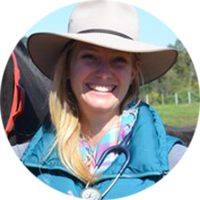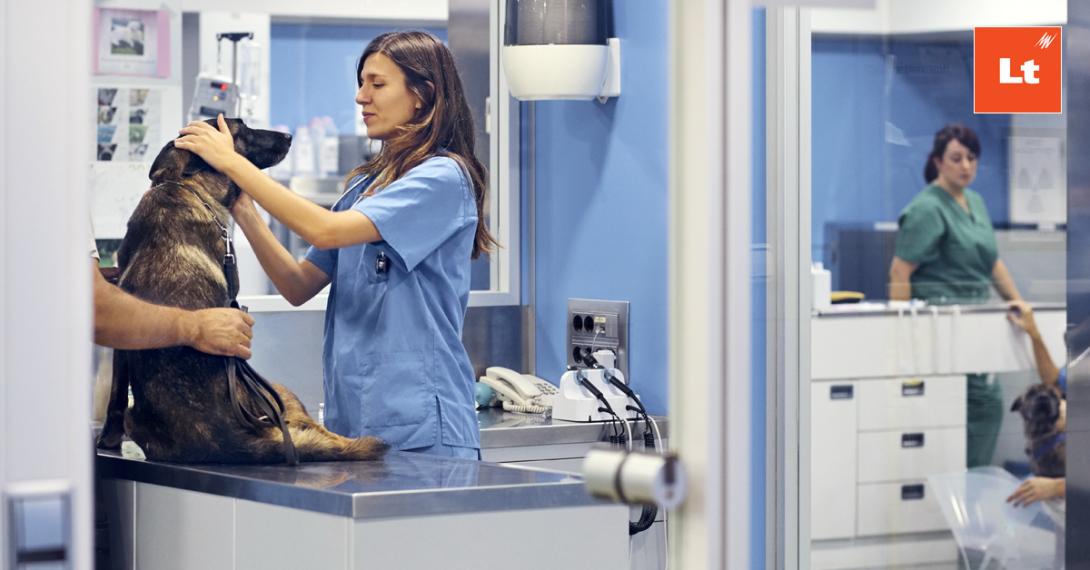Professor Elizabeth Tudor and Dr. Christina Marth use technology to teach in the integrated, systems-based Doctor of Veterinary Medicine at the University of Melbourne.
Australia is crying out for more vets, and the need for quality veterinary education is strong.
We spoke with Elizabeth and Christina to discover how they became educators, the challenges they face in veterinary education, and the recommendations they have for other educators in the field.

Dr. Christina Marth
A love for animal science
While Christina is from Germany and Elizabeth is from Australia, both educators are passionate about animals and problem-solving. Their doctorates and subsequent careers in veterinary science have provided plenty of both! As a discipline, veterinary science allows you to integrate fundamental science and clinical reasoning to solve real-world problems.
At the University of Melbourne, Elizabeth and Christina teach into the 4-year postgraduate Doctorate of Veterinary Medicine (DVM).
Elizabeth has been involved in teaching and veterinary curriculum development over the last 20 years, and in 2020 was named Member of the Order of Australia for her services to veterinary science, animal welfare, and higher education.

Professor Elizabeth Tudor
Teaching became a passion soon after her training in vet school: “I started teaching one year out of vet school and just loved it.” Through Elizabeth’s efforts, the DVM was developed and internationally accredited.
Christina also enjoys working in education, and started teaching during her PhD. “Like Liz, once I started it, I realized that I really enjoy it.” Alongside her research into the physiology and pathology of animal reproduction, she has completed teaching qualifications and loves creating lightbulb moments for her students: “When you explain a complex concept, and you can see when it clicks - I think that's probably what I find most exciting.”
Connecting veterinary students to science through stories
Elizabeth and Christina take a holistic view of animal science. For them, it’s important that veterinary students build an interconnected web of understanding that spans physiology, pathology, anatomy, and more. One way to do this is by telling stories and using case studies.
Learn about how you can apply case studies in your teaching with instructional designer, Vicky:
As Elizabeth says, “I think that human beings are intrinsically storytellers, and when you can create a story around a really exciting physiological, pharmacological, pathological problem, and create that sense of excitement for students, I think that's a wonderful thing to be able to do.”
The students who enter the DVM at the University of Melbourne come from a variety of different backgrounds - as Elizabeth explains, “We've got young people who have been animal techs in a busy US veterinary hospital for 5 years; we've got people coming in with agriculture degrees; with PhDs in biochemistry - all manner of different things.”

Students in the DVM bring different experiences to the course.
This variety of experience means that students have different perspectives and knowledge. Students will often ask questions that challenge their teachers and push them into new territory. Elizabeth enjoys the fact that students are often not constrained by an established scientific worldview: “When you've been sharing something with students, and then they feed it back to you, and it's clear that they've understood it, and they've actually pushed you further and often their questions take you into new territory that you haven't even thought of - that is pretty exciting.”
Teaching veterinary science during COVID-19
The DVM is a significant program within the Faculty of Science at the University of Melbourne, whose vet school is currently ranked 21st in the world (QS World University Rankings, 2022). The key characteristic of this 4-year program is its integrated nature, says Elizabeth.
“Our program takes an integrated systems-based approach from the very first week. For example, during first-year, they're studying the digestive system, so they'll be studying the anatomy, physiology, pharmacology, pathology, and the imaging of the digestive system all at the one time. "
"Previously, we would have studied anatomy and physiology in separate subjects in year one, pathology in year two, and then we would have started to think about imaging and disease processes in year three. So it's an integrated program, and there are not that many programs around the world that are as integrated as ours.”
The widespread disruption caused by the COVID-19 pandemic inevitably affected how the DVM was taught. Elizabeth reflects on the experience: “At the start of COVID, we were desperately struggling to pivot our teaching online, and it was a colleague in the Agriculture school who shared how they'd been using Lt to teach physiology prior to COVID.”
Fortunately, the learning curve for adopting Lt was short and the two educators are now enjoying adapting the Lt Anatomy Collection and building their own veterinary medicine lessons in Lt. “Lt made it really easy to put content together, and I think the reason students love it so much is the feedback element.”
The importance of clinical case studies in veterinary medicine
Clinical reasoning is the holy grail for DVM students. ”When I have the privilege of speaking to the students on their last day in final year, I finish off with a slide which has a veterinary blessing for them," says Elizabeth.
‘May the power of basic science solve your clinical conundrums.'
She explains, “Where pattern recognition comes up short, and you have to fall back on clinical reasoning, that relies on you understanding the fundamentals of the science. So what system is involved? How is that system involved? What's gone wrong with the system? What should it be doing?”
Because clinical reasoning is a key competency for professional vets, each week in the first and second year of the DVM ends with a clinical case study. Elizabeth describes an example:
| Week focus: Digestion and absorption | |
|---|---|
| Case study at end of week: Intestinal lymphosarcoma in a cat | |
| Approach |
|
| Questions |
|
| Desired outcomes |
|
Related: Learn about the 11 animal case studies in the Lt Veterinary Physiology Collection »
The two vet educators use Lt for histology across all first-year subjects, and also in a number of physiology practical labs, for example blood pressure and ECG. By connecting transducers, students can record physiological data live into the Lt platform and more easily relate theory to practice.
Related: Learn more about Lt Sensors for physiological sampling »
Elizabeth made the most of Lt’s editable nature - “I tried to personalize the physiology practicals in Lt as much as I could by, for example, including diagrams out of my lecture notes. Students have the sense that this is something that's been developed specifically for them, and so they immediately engage with it.”
Similarly, Christina has created her own modified content, and says, “Building the content is so fun and so easy - you just click on the plus, and it comes up, and you just choose what you want.”
Common challenges in veterinary education
One challenge when teaching veterinary students is encouraging them to become independent learners. Sometimes students have a tendency to focus on what will be in the exam, and lose sight of the deeper understandings they need to develop to become competent vets in the long-term.

Students can tend to focus on the exam, rather than on long-term retention of information.
According to Elizabeth, “The most disappointing thing you hear from a student is, ‘Tell me what I need to know,’ and ‘Is this going to be on the exam.’ So moving students beyond that point is the challenge.”
Again, telling stories and providing case studies to boost the relevance of course content can help with this journey to becoming a life-long learner.
Related: Webinar: What makes a good online lesson in veterinary education? »
Another issue for vet students, says Christina, is that “There's so much content that they have to be a bit strategic in what they learn. It's a challenge to give the students the time to get to that deeper level of understanding, knowing that they have so much content that needs to fit into their brains.”
One way to help is to make course content accessible to students at all times and allow many opportunities for revision.
Tips for veterinary science educators
1. Try to avoid overloading students with information
Elizabeth recommends asking yourself:
- What is the fundamental core content that students require?
- What are the principles students need to understand to develop their clinical reasoning powers?
- Do students have enough time to reflect?
2. Focus on learning outcomes
Christina makes the point that, “You have to be guided by the learning outcomes, not the technology.” While technology can provide many opportunities, it’s important to stay focused on what students need to know.
Related: How to format learning objectives to improve student learning »
3. Provide feedback to relieve student anxiety
In Lt, “all the little feedback tools make a huge difference,” says Elizabeth. Providing formative feedback can reassure students and save educators time. Try to provide feedback that is not simply “Good job!”, or "Try again!”, but instead explain the key concept and suggest how students could approach the problem.
4. Personalize your vet science curriculum
Elizabeth and Christina took ready-made labs in Lt and personalized them for students so they felt seen and supported within their context. By including the institution’s logo, unique diagrams, and other content she had developed, she ensured that students knew the lessons had been developed “specifically for them”.
5. Shake up the typical lecture format
Within the DVM at the University of Melbourne, lectures are still available online. However, Christina believes that online lectures produce “very passive learning. I think that [Lt provides] a great opportunity to change how we're teaching - use some formats that are not lectures, and then use the time spent in lectures to focus on problem-solving activities once the content is there.” Students can engage with videos, images, and various quiz formats to deepen their understanding of your lessons.
Looking to the future
Both educators will continue to use Lt for their vet science curriculum in the coming years, and are considering adding more case studies to the platform. ”Lt is somewhat addictive, you know, it's such fun to use that you just want to keep doing it, and just a little bit more, a little bit more,” says Elizabeth.
Quality education is crucial to maintaining a supply of confident and competent vets, and we look forward to seeing how Christina and Elizabeth continue to innovate with their teaching approaches!
Are you curious about how you can use Lt in your teaching? Learn more about the Lt Veterinary Physiology Collection »

Professor Elizabeth Tudor
Professor Elizabeth Tudor,
Honorary Professorial Fellow,
Melbourne Veterinary School,
Faculty of Science, The University of Melbourne.
Elizabeth graduated with a PhD from Monash University and served as the Associate Dean, Curriculum Strategy in the Faculty of Veterinary and Agricultural Sciences at The University of Melbourne from 2008 until 2018.
She was instrumental in the development and accreditation of the Doctor of Veterinary Medicine at this institution, and in 2020 was honored as a Member of the Order of Australia for her services to veterinary science, higher education, and animal welfare.
Elizabeth continues to teach into the DVM at The University of Melbourne, and has received multiple teaching awards within the university and nationally.

Dr. Christina Marth
Dr Christina Marth,
Lecturer in Veterinary Biosciences,
Faculty of Science, The University of Melbourne.
Christina graduated with a PhD in veterinary science from the University of Melbourne in 2016. Christina’s teaching is focused in the preclinical years of the DVM, and she has completed multiple qualifications in teaching, including a Graduate Certificate in University Teaching.
She is currently the Chair of the Melbourne Academy for Vet. & Ag. Learning & Teaching (MAVALT).
Christina’s research interests lie in animal reproduction; she first focused on relevant immune factors in horses and now publishes research on various species.
